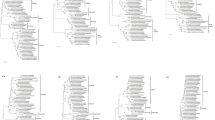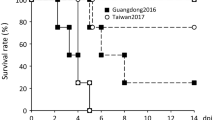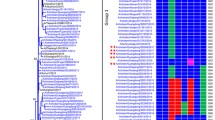Abstract
Decades have passed since the first discovery of H10-subtype avian influenza virus (AIV) in chickens in 1949, and it has been detected in many species including mammals such as minks, pigs, seals and humans. Cases of human infections with H10N8 viruses identified in China in 2013 have raised widespread attention. Two novel reassortant H10N3 viruses were isolated from chickens in December 2019 in eastern China during routine surveillance for AIVs. The internal genes of these viruses were derived from genotype S (G57) H9N2 and were consistent with H5N6, H7N9 and H10N8, which cause fatal infections in humans. Their viral pathogenicity and transmissibility were further studied in different animal models. The two H10N3 isolates had low pathogenicity in chickens and were transmitted between chickens via direct contact. These viruses were highly pathogenic in mice and could be transmitted between guinea pigs via direct contact and respiratory droplets. More importantly, these viruses can bind to both human-type SAα-2,6-Gal receptors and avian-type SAα-2,3-Gal receptors. Asymptomatic shedding in chickens and good adaptability to mammals of these H10N3 isolates would make it easier to transmit to humans and pose a threat to public health.
Similar content being viewed by others
References
Abed, Y., Goyette, N., and Boivin, G. (2005). Generation and characterization of recombinant influenza A (H1N1) viruses harboring amantadine resistance mutations. Antimicrob Agents Chemother 49, 556–559.
Arai, Y., Kawashita, N., Ibrahim, M.S., Elgendy, E.M., Daidoji, T., Ono, T., Takagi, T., Nakaya, T., Matsumoto, K., and Watanabe, Y. (2019). PB2 mutations arising during H9N2 influenza evolution in the Middle East confer enhanced replication and growth in mammals. PLoS Pathog 15, e1007919.
Arzey, G.G., Kirkland, P.D., Arzey, K.E., Frost, M., Maywood, P., Conaty, S., Hurt, A.C., Deng, Y.M., Iannello, P., Barr, I., et al. (2012). Influenza virus A (H10N7) in chickens and poultry abattoir workers, Australia. Emerg Infect Dis 18, 814–816.
Barber, M.R.W., Aldridge Jerry R. J., Webster, R.G., and Magor, K.E. (2010). Association of RIG-I with innate immunity of ducks to influenza. Proc Natl Acad Sci USA 107, 5913–5918.
Berg, M., Englund, L., Abusugra, I.A., Klingeborn, B., and Linné, T. (1990). Close relationship between mink influenza (H10N4) and concomitantly circulating avian influenza viruses. Archives Virol 113, 61–71.
Bi, Y., Li, J., Li, S., Fu, G., Jin, T., Zhang, C., Yang, Y., Ma, Z., Tian, W., Li, J., et al. (2020). Dominant subtype switch in avian influenza viruses during 2016–2019 in China. Nat Commun 11, 5909.
Bodewes, R., Bestebroer, T.M., van der Vries, E., Verhagen, J.H., Herfst, S., Koopmans, M.P., Fouchier, R.A.M., Pfankuche, V.M., Wohlsein, P., Siebert, U., et al. (2015). Avian influenza A(H10N7) virus-associated mass deaths among harbor seals. Emerg Infect Dis 21, 720–722.
Chen, H.Y., Yuan, H., Gao, R., Zhang, J., Wang, D., Xiong, Y., Fan, G.Y., Yang, F., Li, X., Zhou, J., et al. (2014). Clinical and epidemiological characteristics of a fatal case of avian influenza A H10N8 virus infection: a descriptive study. Lancet 383, 714–721.
Chen, Y., Liang, W., Yang, S., Wu, N., Gao, H., Sheng, J., Yao, H., Wo, J., Fang, Q., Cui, D., et al. (2013). Human infections with the emerging avian influenza A H7N9 virus from wet market poultry: clinical analysis and characterisation of viral genome. Lancet 381, 1916–1925.
El-Shesheny, R., Franks, J., Marathe, B.M., Hasan, M.K., Feeroz, M.M., Krauss, S., Vogel, P., McKenzie, P., Webby, R.J., and Webster, R.G. (2018). Genetic characterization and pathogenic potential of H10 avian influenza viruses isolated from live poultry markets in Bangladesh. Sci Rep 8, 10693.
Fan, S., Deng, G., Song, J., Tian, G., Suo, Y., Jiang, Y., Guan, Y., Bu, Z., Kawaoka, Y., and Chen, H. (2009). Two amino acid residues in the matrix protein M1 contribute to the virulence difference of H5N1 avian influenza viruses in mice. Virology 384, 28–32.
Gao, R., Cao, B., Hu, Y., Feng, Z., Wang, D., Hu, W., Chen, J., Jie, Z., Qiu, H., Xu, K., et al. (2013). Human infection with a novel avian-origin influenza A (H7N9) virus. N Engl J Med 368, 1888–1897.
Gao, Y., Zhang, Y., Shinya, K., Deng, G., Jiang, Y., Li, Z., Guan, Y., Tian, G., Li, Y., Shi, J., et al. (2009). Identification ofamino acids in HA and PB2 critical for the transmission of H5N1 avian influenza viruses in a mammalian host. PLoS Pathog 5, e1000709.
Gu, J., Gu, M., Yan, Y., Liu, K., Wang, X., Xu, X., and Liu, X. (2020). Detection of PB2 627K mutation in two highly pathogenic isolates of the H7N9 subtype Influenza a virus from chickens in Northern China. J Infect 81, 979–997.
Gu, M., Chen, H., Li, Q., Huang, J., Zhao, M., Gu, X., Jiang, K., Wang, X., Peng, D., and Liu, X. (2014). Enzootic genotype S of H9N2 avian influenza viruses donates internal genes to emerging zoonotic influenza viruses in China. Vet Microbiol 174, 309–315.
Hai, R., Schmolke, M., Leyva-Grado, V.H., Thangavel, R.R., Margine, I., Jaffe, E.L., Krammer, F., Solórzano, A., García-Sastre, A., Palese, P., et al. (2013). Influenza A(H7N9) virus gains neuraminidase inhibitor resistance without loss of in vivo virulence or transmissibility. Nat Commun 4, 2854.
Hayden, F.G., Cote, K.M., and Douglas Jr, R.G. (1980). Plaque inhibition assay for drug susceptibility testing of influenza viruses. Antimicrob Agents Chemother 17, 865–870.
Joseph, U., Su, Y.C.F., Vijaykrishna, D., and Smith, G.J.D. (2017). The ecology and adaptive evolution of influenza A interspecies transmission. Influenza Other Respi Viruses 11, 74–84.
Kirui, J., Bucci, M.D., Poole, D.S., and Mehle, A. (2014). Conserved features of the PB2 627 domain impact influenza virus polymerase function and replication. J Virol 88, 5977–5986.
Kong, H., Ma, S., Wang, J., Gu, C., Wang, Z., Shi, J., Deng, G., Guan, Y., and Chen, H. (2019). Identification of key amino acids in the PB2 and M1 proteins of H7N9 influenza virus that affect its transmission in guinea pigs. J Virol 94.
Kuchipudi, S.V., Nelli, R., White, G.A., Bain, M., Chang, K.C., and Dunham, S. (2009). Differences in influenza virus receptors in chickens and ducks: Implications for interspecies transmission. J Mol Genet Med 03, 143–151.
Liu, K., Gao, R., Gu, M., Li, J., Shi, L., Sun, W., Liu, D., Gao, Z., Wang, X., Hu, J., et al. (2018). Genetic and biological characterization of two reassortant H5N2 avian influenza A viruses isolated from waterfowl in China in 2016. Vet Microbiol 224, 8–16.
Long, J.S., Mistry, B., Haslam, S.M., and Barclay, W.S. (2019). Host and viral determinants of influenza A virus species specificity. Nat Rev Microbiol 17, 67–81.
Lowen, A.C., Mubareka, S., Tumpey, T.M., García-Sastre, A., and Palese, P. (2006). The guinea pig as a transmission model for human influenza viruses. Proc Natl Acad Sci USA 103, 9988–9992.
Luk, G.S.M., Leung, C.Y.H., Sia, S.F., Choy, K.T., Zhou, J., Ho, C.C.K., Cheung, P.P.H., Lee, E.F., Wai, C.K.L., Li, P.C.H., et al. (2015). Transmission of H7N9 influenza viruses with a polymorphism at PB2 residue 627 in chickens and ferrets. J Virol 89, 9939–9951.
Ma, C., Lam, T.T.Y., Chai, Y., Wang, J., Fan, X., Hong, W., Zhang, Y., Li, L., Liu, Y., Smith, D.K., etal. (2015). Emergence and evolution of H10 subtype influenza viruses in poultry in China. J Virol 89, 3534–3541.
Nilsson, B.E., Te Velthuis, A.J.W., and Fodor, E. (2017). Role of the PB2 627 domain in influenza A virus polymerase function. J Virol 91.
Ning, Z.Y., Luo, M.Y., Qi, W.B., Yu, B., Jiao, P.R., and Liao, M. (2009). Detection of expression of influenza virus receptors in tissues of BALB/c mice by histochemistry. Vet Res Commun 33, 895–903.
OIE, A.H.S. (2015). Manual of Diagnostic Tests and Vaccines for Terrestrial Animals. Bull Office Int Des Épi 1, 1092–1106.
Organization, P.A.H. (2004). Avian influenza virus A (H10N7) circulating among humans in Egypt. Washington: Pan American Health Organization.
Pu, J., Wang, S., Yin, Y., Zhang, G., Carter, R.A., Wang, J., Xu, G., Sun, H., Wang, M., Wen, C., et al. (2015). Evolution of the H9N2 influenza genotype that facilitated the genesis of the novel H7N9 virus. Proc Natl Acad Sci USA 112, 548–553.
Reed, L.J., and Muench, H. (1938). A simple method of estimating fifty per cent endpoints. Am J Epidemiol 27, 493–497.
Shen, Y.Y., Ke, C.W., Li, Q., Yuan, R.Y., Xiang, D., Jia, W.X., Yu, Y.D., Liu, L., Huang, C., Qi, W.B., et al. (2016). Novel reassortant avian influenza A(H5N6) viruses in humans, Guangdong, China, 2015. Emerg Infect Dis 22, 1507–1509.
Song, H., Qi, J., Xiao, H., Bi, Y., Zhang, W., Xu, Y., Wang, F., Shi, Y., and Gao, G.F. (2017). Avian-to-human receptor-binding adaptation by influenza A virus hemagglutinin H4. Cell Rep 20, 1201–1214.
Steel, J., Lowen, A.C., Mubareka, S., and Palese, P. (2009). Transmission of influenza virus in a mammalian host is increased by PB2 amino acids 627K or 627E/701N. PLoS Pathog 5, e1000252.
Sun, Y.F., Wang, X.H., Li, X.L., Zhang, L., Li, H.H., Lu, C., Yang, C.L., Feng, J., Han, W., Ren, W.K., et al. (2016). Novel triple-reassortant H1N1 swine influenza viruses in pigs in Tianjin, Northern China. Vet Microbiol 183, 85–91.
Taft, A.S., Ozawa, M., Fitch, A., Depasse, J.V., Halfmann, P.J., Hill-Batorski, L., Hatta, M., Friedrich, T.C., Lopes, T.J.S., Maher, E.A., et al. (2015). Identification of mammalian-adapting mutations in the polymerase complex of an avian H5N1 influenza virus. Nat Commun 6, 7491.
Taubenberger, J.K., and Kash, J.C. (2010). Influenza virus evolution, host adaptation, and pandemic formation. Cell Host Microbe 7, 440–451.
Teng, Q., Xu, D., Shen, W., Liu, Q., Rong, G., Li, X., Yan, L., Yang, J., Chen, H., Yu, H., et al. (2016). A single mutation at position 190 in hemagglutinin enhances binding affinity for human type sialic acid receptor and replication of H9N2 avian influenza virus in mice. J Virol 90, 9806–9825.
Thompson, A.J., and Paulson, J.C. (2021). Adaptation of influenza viruses to human airway receptors. J Biol Chem 296, 100017.
Wang, N., Zou, W., Yang, Y., Guo, X., Hua, Y., Zhang, Q., Zhao, Z., and Jin, M. (2012). Complete genome sequence of an H10N5 avian influenza virus isolated from pigs in central China. J Virol 86, 13865–13866.
Wu, H., Lu, R., Wu, X., Peng, X., Xu, L., Cheng, L., Lu, X., Jin, C., Xie, T., Yao, H., et al. (2015). Isolation and characterization of a novel H10N2 avian influenza virus from a domestic duck in Eastern China. Infection Genets Evol 29, 1–5.
Xiang, B., Chen, L., Xie, P., Lin, Q., Liao, M., and Ren, T. (2020). Wild bird-origin H5N6 avian influenza virus is transmissible in guinea pigs. J Infect 80, e20–e22.
Yamada, S., Suzuki, Y., Suzuki, T., Le, M.Q., Nidom, C.A., Sakai-Tagawa, Y., Muramoto, Y., Ito, M., Kiso, M., Horimoto, T., et al. (2006). Haemagglutinin mutations responsible for the binding of H5N1 influenza A viruses to human-type receptors. Nature 444, 378–382.
Yoon, S.W., Webby, R.J., and Webster, R.G. (2014). Evolution and ecology of influenza A viruses. In: Compans, R., and Oldstone, M., eds. Influenza Pathogenesis and Control-Volume I. Current Topics in Microbiology and Immunology, Cham: Springer. 359–375.
Zhang, M., Zhang, X., Xu, K., Teng, Q., Liu, Q., Li, X., Yang, J., Xu, J., Chen, H., Zhang, X., et al. (2016). Characterization of the pathogenesis of H10N3, H10N7, and H10N8 subtype avian influenza viruses circulating in ducks. Sci Rep 6, 34489.
Zhang, Y., Zhao, C., Hou, Y., Chen, Y., Meng, F., Zhuang, Y., Liu, L., Suzuki, Y., Shi, J., Deng, G., et al. (2021). Pandemic threat posed by H3N2 avian influenza virus. Sci China Life Sci doi: https://doi.org/10.1007/s11427-021-1916-4.
Zhao, Z., Liu, L., Guo, Z., Zhang, C., Wang, Z., Wen, G., Zhang, W., Shang, Y., Zhang, T., Jiao, Z., et al. (2019). A novel reassortant avian H7N6 influenza virus is transmissible in guinea pigs via respiratory droplets. Front Microbiol 10, 18.
Acknowledgements
This work was supported by the National Key Research and Development Project of China (2016YFD0500202-1, 2016YFD0501601), the National Natural Science Foundation of China (31 772755), Jiangsu Provincial Natural Science Fund for Excellent Young Scholars (BK20170068), the Earmarked Fund For China Agriculture Research System (CARS-40), the Open Project Program of Jiangsu Key Laboratory of Zoonosis (R1808) and the Priority Academic Program Development of Jiangsu Higher Education Institutions (PAPD).
Author information
Authors and Affiliations
Corresponding authors
Ethics declarations
Compliance and ethics The author(s) declare that they have no conflict of interest.
Rights and permissions
About this article
Cite this article
Liu, K., Ding, P., Pei, Y. et al. Emergence of a novel reassortant avian influenza virus (H10N3) in Eastern China with high pathogenicity and respiratory droplet transmissibility to mammals. Sci. China Life Sci. 65, 1024–1035 (2022). https://doi.org/10.1007/s11427-020-1981-5
Received:
Accepted:
Published:
Issue Date:
DOI: https://doi.org/10.1007/s11427-020-1981-5




